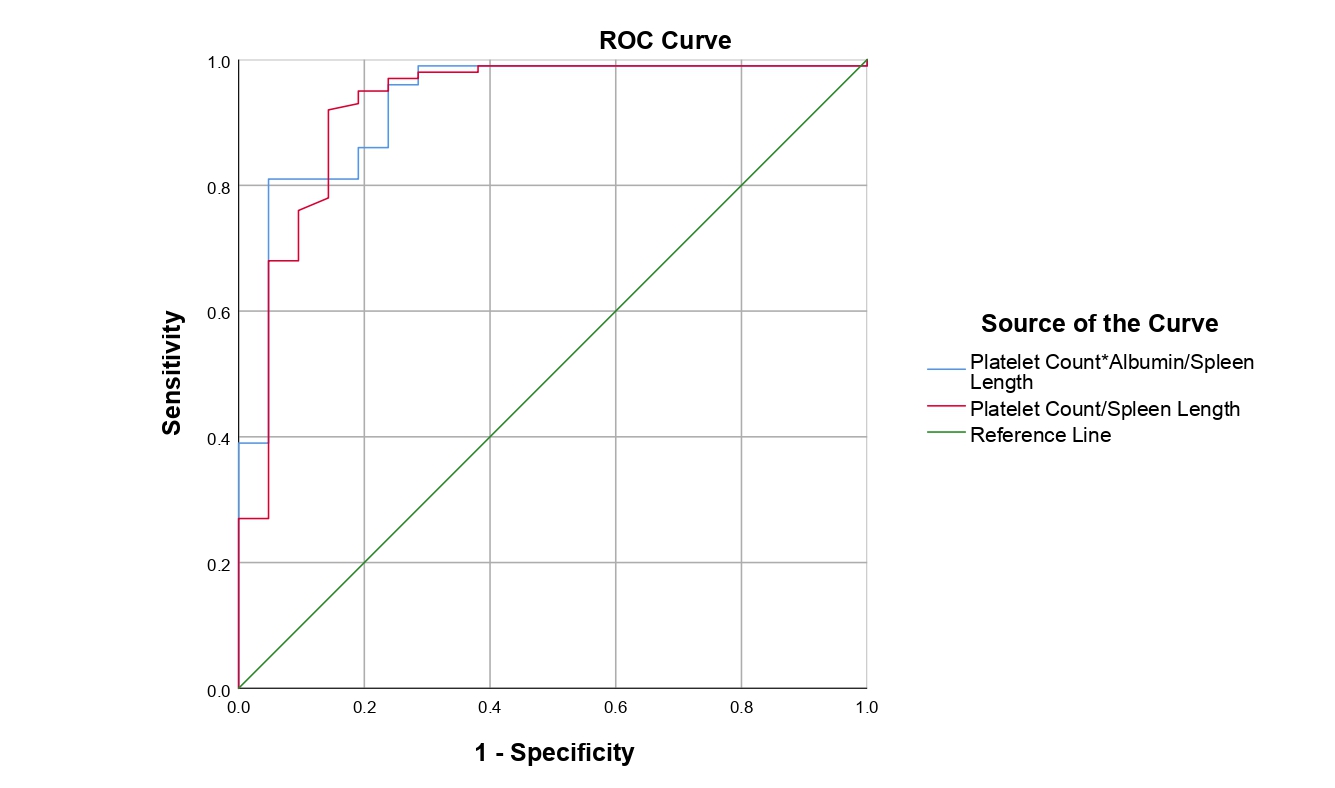Sunday Poster Session
Category: Liver
P1517 - Role of Platelet/Spleen Length Ratio and a Novel Platelet–Albumin/Spleen Length Ratio as Non-Invasive Predictors of Esophageal Varices in Chronic Liver Disease: A Cross-Sectional Study From Eastern India
Sunday, October 26, 2025
3:30 PM - 7:00 PM PDT
Location: Exhibit Hall

Ratnadeep Biswas, MBBS (he/him/his)
ESIC Medical College & Hospital, Bihta, Patna
Patna, Bihar, India
Presenting Author(s)
Ratnadeep Biswas, MBBS1, Vishnu Ojha, MBBS2, Sudheer Varma, MD3, Vijay Kumar, MD2, Divendu Bhushan, MD2, Ramesh Kumar, DM2, Rajeev Priyadarshi, MD2
1ESIC Medical College & Hospital, Bihta, Patna, Patna, Bihar, India; 2All India Institute of Medical Sciences, Patna, Patna, Bihar, India; 3Indira Gandhi Institute of Medical Sciences, Patna, Patna, Bihar, India
Introduction: Early identification of esophageal varices (EVs) in patients with chronic liver disease (CLD) is critical to prevent life-threatening gastrointestinal bleeding. However, in resource-poor settings, access to endoscopy is often limited, underscoring the need for reliable, low cost, non-invasive predictive tools. While the Platelet-to-Spleen Length (P/SL) ratio is a validated surrogate marker, it does not incorporate hepatic synthetic function. We propose a novel composite metric, the Platelet × Albumin / Spleen Length (P*Alb/SL) ratio, that integrates serum albumin levels to enhance specificity for predicting EVs in patients with CLD.
Methods: In this cross-sectional study, 121 adult CLD patients at a tertiary hospital in Eastern India were enrolled. Patients with prior EV treatment, active GI bleeding, hematologic conditions, viral illness, or beta-blocker use were excluded. Platelet count, serum albumin, and spleen length (ultrasound) were recorded. P/SL was calculated as platelet count (cells/µL) divided by spleen length (mm) and P*Alb/SL as (platelet count × albumin [g/dL]) divided by spleen length. All patients underwent upper GI endoscopy to detect and grade EVs. ROC curve analysis determined optimal cutoffs. Diagnostic performance was compared using AUC, sensitivity, specificity, diagnostic odds ratios (DOR), and DeLong’s test.
Results: EVs were identified in 100/121 patients (82.6%), most commonly Grade III (33.9%). Patients with EVs had significantly lower platelet counts, serum albumin, P/SL, and P*Alb/SL values (all p < 0.001). A P/SL cutoff of 856 yielded AUC 0.924 (95% CI: 0.849–0.998), sensitivity 92%, specificity 85.7% and DOR 69. A P*Alb/SL cutoff of 2194.5 yielded AUC 0.98 (95% CI: 0.864–0.992), sensitivity 81%, specificity 95.2%, and DOR 85.26. Both ratios exhibited strong diagnostic performance, with no significant difference between their AUCs (p = 0.712).
Discussion: The P/SL ratio proved to be an effective screening tool for EVs in CLD, with high sensitivity for early detection. The novel P*Alb/SL ratio, which incorporates albumin as a proxy for liver synthetic function, showed comparable AUC but markedly higher specificity, making it ideal for confirmation. In resource-limited settings, a stepwise tandem approach using P/SL for screening and then P*Alb/SL for confirmation could optimize endoscopic triaging, reduce unnecessary procedures, and improve clinical outcomes through better risk stratification.

Figure: Receiver operating curves of the predictors for esophageal varices in chronic liver disease patients
Disclosures:
Ratnadeep Biswas indicated no relevant financial relationships.
Vishnu Ojha indicated no relevant financial relationships.
Sudheer Varma indicated no relevant financial relationships.
Vijay Kumar indicated no relevant financial relationships.
Divendu Bhushan indicated no relevant financial relationships.
Ramesh Kumar indicated no relevant financial relationships.
Rajeev Priyadarshi indicated no relevant financial relationships.
Ratnadeep Biswas, MBBS1, Vishnu Ojha, MBBS2, Sudheer Varma, MD3, Vijay Kumar, MD2, Divendu Bhushan, MD2, Ramesh Kumar, DM2, Rajeev Priyadarshi, MD2. P1517 - Role of Platelet/Spleen Length Ratio and a Novel Platelet–Albumin/Spleen Length Ratio as Non-Invasive Predictors of Esophageal Varices in Chronic Liver Disease: A Cross-Sectional Study From Eastern India, ACG 2025 Annual Scientific Meeting Abstracts. Phoenix, AZ: American College of Gastroenterology.
1ESIC Medical College & Hospital, Bihta, Patna, Patna, Bihar, India; 2All India Institute of Medical Sciences, Patna, Patna, Bihar, India; 3Indira Gandhi Institute of Medical Sciences, Patna, Patna, Bihar, India
Introduction: Early identification of esophageal varices (EVs) in patients with chronic liver disease (CLD) is critical to prevent life-threatening gastrointestinal bleeding. However, in resource-poor settings, access to endoscopy is often limited, underscoring the need for reliable, low cost, non-invasive predictive tools. While the Platelet-to-Spleen Length (P/SL) ratio is a validated surrogate marker, it does not incorporate hepatic synthetic function. We propose a novel composite metric, the Platelet × Albumin / Spleen Length (P*Alb/SL) ratio, that integrates serum albumin levels to enhance specificity for predicting EVs in patients with CLD.
Methods: In this cross-sectional study, 121 adult CLD patients at a tertiary hospital in Eastern India were enrolled. Patients with prior EV treatment, active GI bleeding, hematologic conditions, viral illness, or beta-blocker use were excluded. Platelet count, serum albumin, and spleen length (ultrasound) were recorded. P/SL was calculated as platelet count (cells/µL) divided by spleen length (mm) and P*Alb/SL as (platelet count × albumin [g/dL]) divided by spleen length. All patients underwent upper GI endoscopy to detect and grade EVs. ROC curve analysis determined optimal cutoffs. Diagnostic performance was compared using AUC, sensitivity, specificity, diagnostic odds ratios (DOR), and DeLong’s test.
Results: EVs were identified in 100/121 patients (82.6%), most commonly Grade III (33.9%). Patients with EVs had significantly lower platelet counts, serum albumin, P/SL, and P*Alb/SL values (all p < 0.001). A P/SL cutoff of 856 yielded AUC 0.924 (95% CI: 0.849–0.998), sensitivity 92%, specificity 85.7% and DOR 69. A P*Alb/SL cutoff of 2194.5 yielded AUC 0.98 (95% CI: 0.864–0.992), sensitivity 81%, specificity 95.2%, and DOR 85.26. Both ratios exhibited strong diagnostic performance, with no significant difference between their AUCs (p = 0.712).
Discussion: The P/SL ratio proved to be an effective screening tool for EVs in CLD, with high sensitivity for early detection. The novel P*Alb/SL ratio, which incorporates albumin as a proxy for liver synthetic function, showed comparable AUC but markedly higher specificity, making it ideal for confirmation. In resource-limited settings, a stepwise tandem approach using P/SL for screening and then P*Alb/SL for confirmation could optimize endoscopic triaging, reduce unnecessary procedures, and improve clinical outcomes through better risk stratification.

Figure: Receiver operating curves of the predictors for esophageal varices in chronic liver disease patients
Disclosures:
Ratnadeep Biswas indicated no relevant financial relationships.
Vishnu Ojha indicated no relevant financial relationships.
Sudheer Varma indicated no relevant financial relationships.
Vijay Kumar indicated no relevant financial relationships.
Divendu Bhushan indicated no relevant financial relationships.
Ramesh Kumar indicated no relevant financial relationships.
Rajeev Priyadarshi indicated no relevant financial relationships.
Ratnadeep Biswas, MBBS1, Vishnu Ojha, MBBS2, Sudheer Varma, MD3, Vijay Kumar, MD2, Divendu Bhushan, MD2, Ramesh Kumar, DM2, Rajeev Priyadarshi, MD2. P1517 - Role of Platelet/Spleen Length Ratio and a Novel Platelet–Albumin/Spleen Length Ratio as Non-Invasive Predictors of Esophageal Varices in Chronic Liver Disease: A Cross-Sectional Study From Eastern India, ACG 2025 Annual Scientific Meeting Abstracts. Phoenix, AZ: American College of Gastroenterology.

